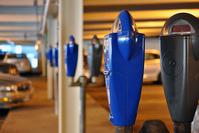Montgomery won’t make (some) businesses fund parking anymore

Photo by BethesdaNow.com Staff on Flickr.
Builders in downtown Bethesda, Silver Spring, and Wheaton are now free to build as little parking as they want, without violating zoning rules or paying extra taxes. The change eliminates a major subsidy to driving and will help these suburban centers evolve into walkable urban areas.
The new policy, enacted as part of the new county budget, is the result of the simpler, more modern zoning code approved a year ago. The rewrite of the zoning ordinance sharply cut the amount of off-street parking required near Metro stations, upsetting a long-established system for financing the county’s public parking garages.
When the county first opened public parking lots, they were a way for stores in old downtown buildings to compete with new malls and their ample free parking. Meter rates were low and downtown buildings paid an extra “parking tax” to meet the expenses. Newer buildings with their own parking were exempt from the tax.
After Metro came to Bethesda and Silver Spring, the downtowns grew denser. But for many years the county kept the tax high to encourage the construction of as much parking as possible when new buildings went up. Unless a building met the parking requirement that the zoning code imposed on auto-oriented development far from Metro, it paid the entire tax.
The new zoning code recognized the downside of too much parking, and it lowered the parking minimums near Metro. When it went into effect last year, many buildings that previously paid the parking tax became exempt. This brought confusion at first, and then a recognition that the parking tax had lost much of its revenue-raising potential.
The new county budget solves this problem by setting the parking tax to zero, and making up the difference with other revenue. (The tax has technically not been abolished. If the county fails to pay back money borrowed to build garages, bond holders can demand its resumption.)
At work here is the interconnected nature of land use planning. Automobile-dependent development has a logic in which parking and highways create a need for more of the same. Once that cycle is broken, a new logic sets in. When things work well, as they did here, advances in livability and walkability beget more progress.
